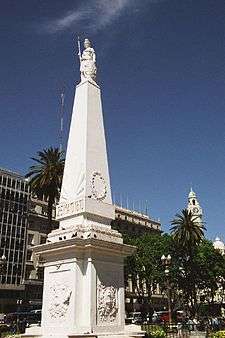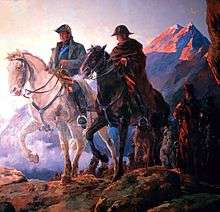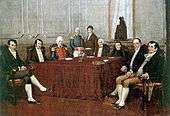Legacy of the May Revolution
The May Revolution (Spanish: Revolución de Mayo) was a week-long series of revolutionary events that took place from May 18 to May 25, 1810, in Buenos Aires. It started the Argentine War of Independence, and it is considered the birth of modern Argentina.

Commemorations
May 25 is a patriotic date in Argentina, known as First Patriotic Government, with the character of a national holiday. The holiday is set by law 21.329 and it is immovable, meaning it is celebrated exactly on May 25 regardless of day of the week.[1] The Bicentennial of Argentina was celebrated in 2010.
May 25 was designated as a patriotic date in 1813, but the Argentine Declaration of Independence provides an alternative national day. In the beginning, this added to the conflicts between Buenos Aires and the provinces during the Argentine Civil War, because the date in May related to Buenos Aires and the date of July 9 related to the whole country.[2] As a result, the unitarian Bernardino Rivadavia canceled the celebration of July 9, and the federalist Juan Manuel de Rosas re-allowed it, but without giving up celebrations in May. By 1880, with the federalization of Buenos Aires, the local connotations were removed and the May Revolution was considered the birth of the nation.[2]
The date, as well as a generic image of the Buenos Aires Cabildo, are used in different variants to honor the May Revolution. Two of the most notable are the Avenida de Mayo and the Plaza de Mayo at Buenos Aires, near the location of the Cabildo. The Pirámide de Mayo was erected in the Plaza a year after the revolution, and was rebuilt to its present form in 1856. "May 25" (in Spanish, "Veinticinco de Mayo") is the name of several administrative divisions, cities, public spaces, and landforms of Argentina. There are departments of this name in the provinces of Chaco, Misiones, San Juan, Rio Negro, and Buenos Aires, the latter one holding the Veinticinco de Mayo city. The cities of Rosario (Santa Fe), Junín (Buenos Aires), and Resistencia (Chaco) have eponymous squares. The King George Island is under sovereignty claims of Argentina, Britain, and Chile, as part of the Argentine Antarctica, British Antarctic Territory, and Chilean Antarctic Territory, with Argentina naming it "Isla 25 de Mayo".
A commemorative Cabildo is used on coins of 25 cents, and an image of the Sun of May appears on the 5-cent coin of the current Argentine Peso. An image of the Cabildo during the Revolution appeared on the back of the 5-peso banknote of the former Peso Moneda Nacional.
In popular culture
The May 25 anniversary is the subject of articles each year in children's magazines in Argentina, for example Billiken, and is described in textbooks used in primary schools. These publications often omit some aspects of the historical event, as their violence and political content might be considered inappropriate for minors, such as the arming of the population following the preparations for the second British invasion, or the class struggle between the Criollos and the Spanish peninsulares. Children's literature often portrays the revolution as an event devoid of violence that inevitably would have happened one way or another, and the emphasis is on secondary issues such as whether or not it rained that day, or whether the use of umbrellas was widespread or limited to a minority.[3] Presented as archetypal of the revolution is the presence of various workers, including a mazamorreros delivering pies among the people in the plaza on May 25. School plays or TV numbers on the national holiday would include such recreated scenes.
The Argentina Centennial led to the creation of many different works and representations. Chilean painter Pedro Subercaseaux created many related paintings after requests from Ángel Carranza, such as Cabildo abierto del 22 de mayo de 1810; Mariano Moreno writing in his desk; the embrace of Maipú between San Martín and Bernardo O'Higgins; and the first playing of the Argentine National Anthem. Such works would later become canonical images.[4] The centennial led to the production of La Revolución de Mayo, an early silent film, shot in 1909 by Mario Gallo; it premiered in 1910. It was the first Argentine fiction film done with professional actors.[5]
Among the songs inspired by the events of May is the "Candombe de 1810". The tango singer Carlos Gardel sang "El Sol del 25", with lyrics by Domingo Lombardi and James Rocca, and "Salve Patria", by Eugenio Cárdenas and Guillermo Barbieri. Peter Berruti, meanwhile, created "Gavota de Mayo" with folk music.
An analysis of the May revolution from the point of view of literary fiction is the 1987 novel La Revolución es un Sueño Eterno (The Revolution is an Eternal Dream), by Andrés Rivera. The narrative is based on the fictional diaries of Juan José Castelli, who was tried for his conduct in the course of the disastrous First Alto Perú campaign. Through the fictional account of a mortally ill Castelli, Rivera criticizes the official history and the nature of the revolution.[6]
The bicentennial in 2010 produced fewer related works than the centennial. Many related books were written close to it, such as 1810, Enigmas de la historia argentina, Hombres de Mayo, and Historias de corceles y de acero.[7]
References
- Law on general holidays and days off shift (in Spanish)
- Sigal, Silvia (2010). "Mayo, la disputa por el sentido". Ñ. Clarín (343): 11.
- Pigna, Felipe (2007). "La Revolución de Mayo". Los mitos de la historia argentina (in Spanish) (26 ed.). Argentina: Grupo Editorial Norma. p. 218. ISBN 987-545-149-5.
Spanish: A lo sumo, el sistema fomenta debates tan trascendentes como la existencia o inexistencia de paraguas en aquellos días de 1810, o sesudos contrapuntos meteorológicos basados en la contradicción marcada por la canción "El sol del 25 viene asomando" y las ilustraciones del Billiken, el Simulcop y el Manual del Alumno, que muestran una plaza indudablemente lluviosa. A esto se pretende reducir, conciente o inconcientemente, el proceso que marcaría a fuego nuestro futuro como Nación.
At most, the system promotes debates such as whether or not umbrellas were required on those days of 1810, or discusses dichotomies based in the contradiction marked by the song "The Sun of the 25 comes rising" and the drawings of Billiken, the Simulcop and the Student's Textbook, which show a plaza clearly rainy. This is intended to reduce, intentionally or unintentionally, the process that would mark with fire our future as nation. - Balmaceda, Daniel (2010). Historias de corceles y de acero. Buenos Aires: Sudamericana. pp. 121–124. ISBN 978-950-07-3180-5.
- La Revolución de Mayo (Mario Gallo, 1909) (in Spanish)
- Nelda Pilia de Assunção, Aurora Ravina, Mónica Larrañaga (1999). Mayo de 1810: entre la historia y la ficción discursivas. Editorial Biblos, pp. 113–122. ISBN 950-786-212-9 (in Spanish)
- Pavón, Héctor (2010). "El espejo lejano del primer centenario". Ñ. Clarín (343): 29.





